The Holy Mountain: Does Real Life Await Us?
Published on December 5th, 2011 in: Blu-Ray, Dancing Ourselves Into The Tomb, DVD/Blu-Ray Reviews, Issues, Movie Reviews, Movies, Underground/Cult |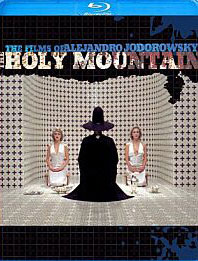
Preface
For those who have never seen an Alejandro Jodorowsky film, describing one seems a daunting task. Furthermore, once you have seen a Jodorowsky film, such descriptions prove to be a poor substitute for the experience itself.
At present, Jodorowsky is 82 years old. With a life full of many artistic accomplishments, a description of them all is beyond the scope of an analysis of his films, but some introduction is needed in the hopes of illuminating how his background has informed his art.
That Beatty Touch: Heaven Can Wait
Published on December 5th, 2011 in: Comedy, Dancing Ourselves Into The Tomb, Issues, Movie Reviews, Movies, Soundtracks and Scores |Although it was released in 1978, Heaven Can Wait was one of my favorite films to watch again and again on HBO in the dawn of the 1980s.
Along with Foul Play, which was released in the same year (and is another fave), it’s a film that’s intended for adults, but which still possesses enough sweetness to appeal to a younger audience.
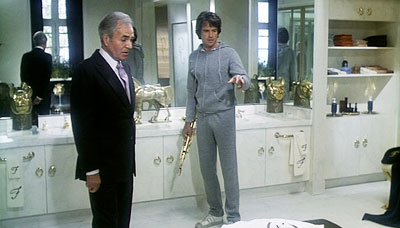
Summer Of Grease
Published on December 5th, 2011 in: Dancing Ourselves Into The Tomb, Issues, Movies, Music, Soundtracks and Scores |By David Speranza
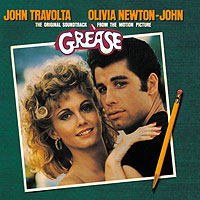
I can’t speak for any adults at the time, but for those of us in our teens when the movie version of Grease hit theaters in 1978, it was more than just the latest in a line of summer-movie blockbusters (a concept that was still fairly new). Imagine, if you dare, two or three Twilight movies condensed into a single summer, with a hit soundtrack by Justin Bieber and Taylor Swift. Grease—with its catchy, inexhaustible pop tunes—represented the crest of the 1950s nostalgia that had been coursing through the decade.
(more…)
Can’t Fight The Fever
Published on December 5th, 2011 in: Dancing Ourselves Into The Tomb, Issues, Movies, Music, Soundtracks and Scores |By David Speranza
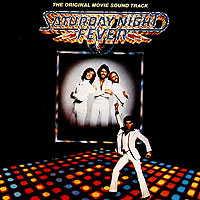
When the movie Saturday Night Fever was released in December of 1977, it became a smash critical and popular success that delivered disco to the masses, John Travolta to movie theaters, and a soundtrack that became the biggest-selling of all time. But in my household, the film’s influence was precisely . . . nil. Considering my family’s strict rock & roll diet, at 13 I didn’t have to be told that a movie about disco was persona non grata. (Say it with me now: “Disco sucks.”) But beyond hewing to the party line, we also thought those high-pitched Bee Gee voices were whiny, nasal, and annoyingly ubiquitous in the months following the film’s release.
And those voices—along with the other Fever songs cramming the airwaves—were everywhere. I don’t remember how many times we’d be driving somewhere when that thumping bass and Gibb-brother whine would suddenly infect the car radio, causing one or the other Woodstock-era parent to reach violently for the tuner with a stream of R-rated invective. I knew the rules: if it had a dance beat, it was shunned—as clear as the laws of physics.
(more…)
So They Were Stars: The Razzle Dazzle Rockin’ Reign of the Hudson Brothers
Published on December 5th, 2011 in: Comedy, Dancing Ourselves Into The Tomb, DVD, Issues, Movies, Music, TV |By Cait Brennan
The Bible says music tore down the mighty walls of Jericho. In the 1960s and ’70s, rock and roll did the same for a generation of girls and young women. The rise of pop culture brought women and girls an unprecedented level of freedom, power, and influence. Perhaps it can’t quite be called “feminist,” and it may seem like a small thing, but before the mid-’60s, before the Beatles and Monkees, who could have imagined whole magazines devoted to pin-up boys?
(more…)
Arkham City: World Of Echo
Published on November 30th, 2011 in: Comics, Feminism, Game Reviews, Gaming, Movies, Over the Gadfly's Nest, Reviews, TV |By Paul Casey
Arkham City, released October 21, is an important Batman story. While perhaps not as unexpected as its predecessor, Arkham Asylum, Rocksteady have turned in a Batman game that builds on that one’s many successes. As someone who has been obsessed with Batman for a couple of decades, with changing degrees of intensity, Arkham City is literally a dream come true.
To have an interactive slab of Gotham City with such extremely detailed and well observed parts of Batman’s long history concealed for your own brand of detective work . . . well, it makes me feel both old and lucky to have been around this long. That the game is actually a wonderful, expertly paced, physical experience is something else entirely. As with Arkham Asylum, it still seems quite unusual to have a great comic book like Batman finally tap into why video games are such an exciting medium.
Everything New Is Old Again: Dorian Gray Films, Past and Present
Published on November 8th, 2011 in: Books, Movies, Reviews |By Lisa Anderson
I recently re-read The Picture of Dorian Gray, Oscar Wilde’s novel about a beautiful but debauched young man whose enchanted portrait takes the brunt of both his years and his misdeeds. Soon afterwards, I got together with a group of fellow horror fans and watched two film adaptations: the1945 Albert Lewin version with Hurt Hatfield in the title role, and the 2009 direct-to-video version with Ben Barnes starring as Dorian. Not surprising in light of the time between them, both movies approach the source material in very different ways. Each deviates from the novel in different ways, and has its own strengths and weaknesses. The variations between the book and each film can be illustrated by discussion the tone of the films, and two pivotal incidents in the story.
(more…)
FIX: The Ministry Movie, Directed By Douglas Freel
Published on October 18th, 2011 in: Current Faves, Documentaries, DVD/Blu-Ray Reviews, Movies, Reviews |By Danny R. Phillips
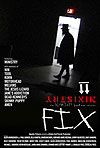
From the wind-ravaged land known as Chicago, Ministry and its lead freak Al Jourgensen, were key in the creation of the soul-rattling, abrasive form of rock known as Industrial.
FIX, a behind the scenes, eyes wide open look at the band during their 1996 SphincTour, is informative and unsettling all at once. So unsettling that Jourgensen tried to stop its release. Luckily for us fans, he recently dropped the lawsuit.
(more…)
The Killing Floor: What Happened At Rue Morgue Festival Of Fear 2011
Published on September 29th, 2011 in: Blu-Ray, Canadian Content, Conventions/Expos, DVD, Halloween, Horror, Movies, Reviews, Science Fiction, Toys and Collectibles, Underground/Cult, Video |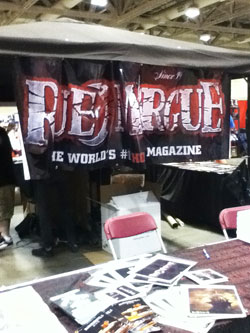
Every August, Rue Morgue hosts its annual horror convention Festival Of Fear as part of FanExpo Canada (which also includes Gaming, Comics, Sci-Fi, and Anime). Every year, I await their list of guests and schedule of events. This year they presented a Near Dark screening with Lance Henriksen (read more here), a Q&A with Tom Savini (read more here), a 30th Anniversary cast and crew reunion for My Bloody Valentine (read more here), and much more, like events and panels with Malcolm McDowell, Robert Englund (Freddy Krueger), Elvira, and John Waters. There are literally too many things for one person to do. If ever there were a compelling reason to clone myself, it would be for Festival of Fear.
A Nocturnal Nomad: Near Dark With Lance Henriksen
Published on September 29th, 2011 in: Canadian Content, Conventions/Expos, Halloween, Horror, Movies, Science Fiction |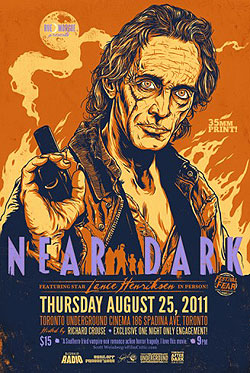
Every year as part of their Festival of Fear, Rue Morgue screens an iconic horror movie accompanied by a special guest. This year, we were treated to a screening of what may be the perfect vampire film, Near Dark, directed by Kathryn Bigelow, with Lance Henriksen (who plays Jesse Hooker) in attendance.
Near Dark is one of those movies that, forgive the cliché, truly improves with age, much like the vampires it portrays. It is even more relevant now than it was when it was originally released in 1987. Back then it was not exactly box office gold, although it has grown in both critical and cult status since.

